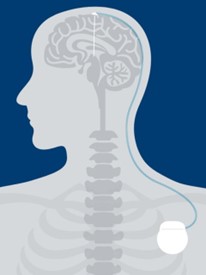 15 April 2024
15 April 2024
Deep Brain Stimulation – or DBS for short - is a treatment for movement disorders like Parkinson’s, Dystonia, or Essential Tremor. Those diseases can come with symptoms like unwanted movements or cramping muscles, impacting the ability of patients to partake in everyday life. The DBS system is an implanted system which can regulate the symptoms through electrical signals.
In a DBS procedure, the physician will place insulated wires called leads into the brain. These leads are then connected via a thin wire (extension) to a small device called a stimulator, which is similar to a pacemaker and typically placed under the skin in the chest. The stimulator then sends mild electrical pulses through the extension and leads to specific regions of the brain. The procedure is minimally invasive and reversible.
Many of the movement disorders are progressive in nature and develop over time, so the disease status can vary greatly from person to person. This is why the treatment should be personalised and its effectiveness closely monitored, so it can be adjusted over time to achieve optimal symptom relief. This is something DBS can achieve, as the electric pulses coming from the stimulator can be adjusted – or programmed – to fit a patient’s individual brain and state for optimal outcomes. DBS is not a cure, but the minimally invasive and reversible procedure may help control some of the disabling symptoms of the conditions and help achieve a better quality of life. Studies indicate the effectiveness of DBS in controlling the symptoms of movement disorders, and that the vast majority of patients would choose DBS again if given the chance.1,2The best way to control any disease progression is to be proactive and start talking to the experts early. A specialist can help find the treatment option that will work best for the individual patient.
Watch this video for more details:
To learn more about movement disorders, watch patient stories, or to find a DBS centre in your area, visit the movement disorder website.
1Krack et al. Five-year follow up of bilateral stimulation of the subthalmaic nucleus in advanced Parkinson’s disease. N Eng J Med. 2003. 349: 1925 – 1934.
2Knoop et al. Bridging the gap in patient education for DBS surgery for Parkinson’s disease. Parkinson’s Disease. 2017. 2017: 1-6.
This material is for informational Purposes only and not meant for medical diagnosis. This information does not constitute medical or legal advice, and Boston Scientific makes no representation regarding the medical benefits included in this information. Boston Scientific strongly recommends that you consult with your physician on all matters pertaining to your health.
CAUTION: The law restricts these devices to sale by or on the order of a physician. Indications, contraindications, warnings, and instructions for use can be found in the product labelling supplied with each device or at www.IFU-BSCI.com. Products shown for INFORMATION purposes only and may not be approved or for sale in certain countries. This material not intended for use in France. 2023 Copyright © Boston Scientific Corporation or its affiliates. All rights reserved.
NM-1763601- AA